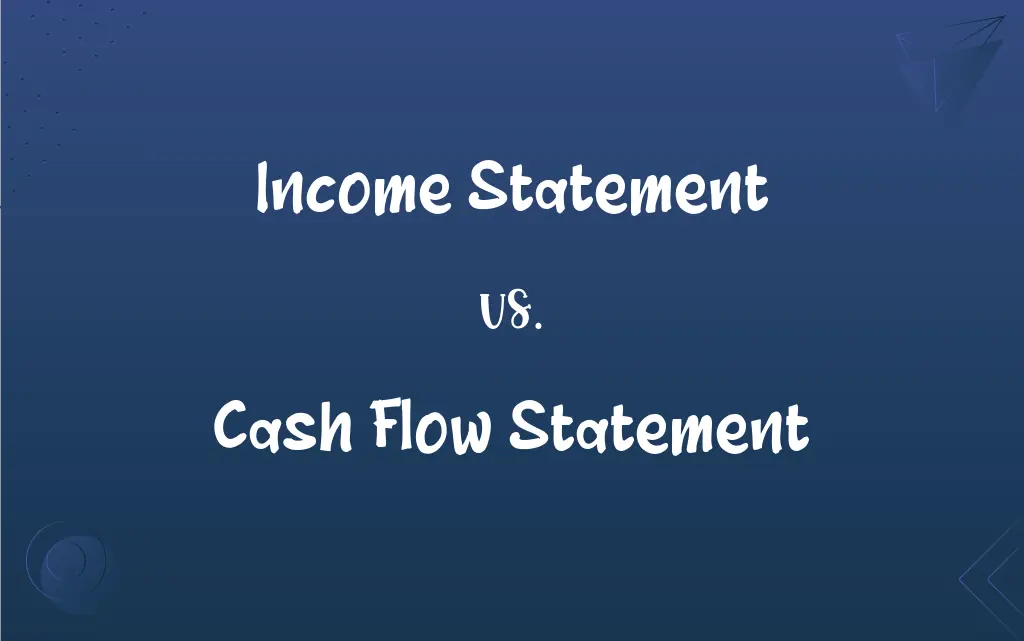Income Statement vs. Cash Flow Statement: What's the Difference?
Edited by Harlon Moss || By Janet White || Published on November 27, 2023
The Income Statement shows a company's profitability over a period, while the Cash Flow Statement tracks cash inflows and outflows during that time.

Key Differences
The Income Statement, often termed as the profit and loss statement, provides an overview of a company's revenues and expenses over a specific period, highlighting its profitability. On the other hand, the Cash Flow Statement offers detailed information about the cash inflows and outflows from operating, investing, and financing activities during a given time frame.
An Income Statement uses accrual accounting, recognizing revenues and expenses when they are earned or incurred, not necessarily when cash changes hands. Conversely, the Cash Flow Statement is concerned solely with the movement of cash, showing when cash is received or paid out.
Items like depreciation or amortization, which are non-cash expenses, might appear on the Income Statement, affecting profitability. However, they won't be present on the Cash Flow Statement since they don't involve cash transactions. In contrast, a significant equipment purchase might not immediately impact the Income Statement, but it would result in a cash outflow in the investing section of the Cash Flow Statement.
The Income Statement provides stakeholders with insights into the core operations of the business and its ability to generate profit. Meanwhile, the Cash Flow Statement offers a deeper look at a company's liquidity and its ability to maintain and grow operations, showcasing how cash is moving in and out of the organization.
While both the Income Statement and Cash Flow Statement are integral parts of a company's financial statements, they serve distinct purposes. One showcases profitability, and the other highlights liquidity and cash management.
ADVERTISEMENT
Comparison Chart
Purpose
Shows profitability
Tracks cash movements
Accounting Method
Accrual-based
Cash-based
Main Sections
Revenues, expenses, profit/loss
Operating, investing, financing activities
Impact of Non-Cash Items
Includes (e.g., depreciation)
Excludes
Indicates
Profitability
Liquidity and cash management
ADVERTISEMENT
Income Statement and Cash Flow Statement Definitions
Income Statement
A summary of an entity's financial performance.
Start-ups might have a negative bottom line in their initial Income Statement.
Cash Flow Statement
A financial document detailing cash inflows and outflows.
The Cash Flow Statement highlighted robust operating cash flows.
Income Statement
A record of earnings and costs for a set duration.
Investors often scrutinize the Income Statement to understand revenue streams.
Cash Flow Statement
A breakdown of cash transactions in a specific period.
According to the Cash Flow Statement, dividends were paid last quarter.
Income Statement
An overview of revenues minus expenses.
The Income Statement revealed a significant increase in net profit.
Cash Flow Statement
A report showcasing liquidity and cash management.
The negative numbers in the Cash Flow Statement raised concerns about the company's solvency.
Income Statement
A statement showing the financial results of operations.
The decline in sales was evident in the quarterly Income Statement.
Cash Flow Statement
An overview of cash movements from various activities.
The Cash Flow Statement indicated substantial investments in new machinery.
Income Statement
A financial report displaying profitability over a period.
The CEO reviewed the Income Statement to assess the year's performance.
Cash Flow Statement
A summary of how cash enters and leaves a business.
The startup's Cash Flow Statement revealed tight liquidity despite profits.
FAQs
What's the primary focus of the Cash Flow Statement?
The Cash Flow Statement tracks cash inflows and outflows from various activities.
Are non-cash expenses reflected in the Cash Flow Statement?
No, the Cash Flow Statement focuses solely on actual cash transactions.
Can a company be profitable but have negative cash flow?
Yes, due to differences between accrual accounting and cash transactions, a company can be profitable but have negative cash flow.
Does the Income Statement include non-cash items like depreciation?
Yes, the Income Statement includes non-cash items affecting profitability.
What can stakeholders infer from an Income Statement?
Stakeholders can gauge a company's ability to generate profit from the Income Statement.
What insights does the Cash Flow Statement provide about a company?
The Cash Flow Statement offers insights into a company's liquidity and cash management.
How can one differentiate operating activities in the Cash Flow Statement from the Income Statement?
Operating activities in the Cash Flow Statement detail cash receipts and payments, while the Income Statement shows all revenues and expenses, whether cash-based or not.
Can a company's Income Statement show a loss while its Cash Flow Statement shows positive cash flow?
Yes, due to items like depreciation or changes in working capital, a company can have a reported loss but positive cash flow.
What does the Income Statement represent?
The Income Statement shows a company's revenues, expenses, and profitability over a period.
How does the Income Statement treat revenues and expenses?
The Income Statement recognizes revenues and expenses when earned or incurred, using accrual accounting.
How are cash transactions represented in the Cash Flow Statement?
The Cash Flow Statement lists cash transactions under operating, investing, or financing activities.
Does the Income Statement account for capital expenditures?
No, capital expenditures are usually reflected in the Cash Flow Statement under investing activities.
Which statement is better for assessing liquidity?
The Cash Flow Statement is better suited for assessing a company's liquidity.
What might cause discrepancies between net income on the Income Statement and cash from operations on the Cash Flow Statement?
Items like depreciation, changes in working capital, or accruals can cause such discrepancies.
Can the Cash Flow Statement be used to assess a company's solvency?
Yes
How do dividends paid appear in the financial statements?
Dividends are not an expense on the Income Statement but are shown as a cash outflow in the financing section of the Cash Flow Statement.
What does a positive net income on the Income Statement indicate?
A positive net income indicates that a company's revenues exceeded its expenses during the period.
About Author
Written by
Janet WhiteJanet White has been an esteemed writer and blogger for Difference Wiki. Holding a Master's degree in Science and Medical Journalism from the prestigious Boston University, she has consistently demonstrated her expertise and passion for her field. When she's not immersed in her work, Janet relishes her time exercising, delving into a good book, and cherishing moments with friends and family.
Edited by
Harlon MossHarlon is a seasoned quality moderator and accomplished content writer for Difference Wiki. An alumnus of the prestigious University of California, he earned his degree in Computer Science. Leveraging his academic background, Harlon brings a meticulous and informed perspective to his work, ensuring content accuracy and excellence.

































































